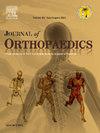Impact of spinopelvic parameters on acetabular cup positioning and patient-reported outcomes following total hip arthroplasty
IF 1.5
Q3 ORTHOPEDICS
引用次数: 0
Abstract
Background
Hip instability is one of the most common complications after total hip arthroplasty (THA). While prior research has explored patient factors, surgical technique, soft tissue dynamics, implant design, and spinopelvic parameters. In particular, the relationship between spinopelvic alignment and acetabular cup positioning is not yet fully understood. Therefore, we aim to evaluate the association between spinopelvic parameters, acetabular cup positioning, and 12-month postoperative PROMs.
Methods
This study included 90 patients undergoing primary THA at a single institution from March 2019 to May 2023. Pelvic parameters (acetabular inclination, acetabular version, pelvic incidence, pelvic tilt, sacral slope, flexion, and obliquity) were assessed using EOS imaging and radiographs. Additional data were obtained from the Veterans RAND-12 survey and the FORCE-TJR database. PROMs were collected preoperatively, at 3 months, and at 12 months postoperatively, along with postoperative hospital metrics. Statistical analysis included Pearson's correlation to evaluate associations between pelvic parameters and PROMs.
Results
Postoperatively, 1.1 % of patients required reoperation, 2.2 % experienced dislocation, 5.5 % were readmitted within 90 days, and 12.1 % had complications, though none were associated with spinopelvic parameters or cup positioning. Acetabular cup inclination was significantly correlated with pelvic tilt (R = 0.30, p = 0.003), while acetabular version showed negative correlations with pelvic incidence (R = −0.23, p = 0.02) and sacral slope (R = −0.31, p = 0.002). At 12 months, acetabular inclination predicted improvement in MCS (R = 0.28, p = 0.02), and obliquity predicted improvements in activities of daily living (R = 0.29, p = 0.02), pain (R = 0.28, p = 0.03), and quality of life (R = 0.30, p = 0.002).
Conclusion
In the first year after THA, acetabular inclination was linked to improved patient-reported outcomes, while greater pelvic obliquity was associated with better scores in activities of daily living, pain, and quality of life. Post-operative acetabular cup version had weak correlations with pelvic incidence, sacral slope, and pelvic tilt. No other associations were found between spinopelvic parameters, cup positioning, and instability or complications.
全髋关节置换术后椎盂参数对髋臼杯定位和患者报告结果的影响
背景:髋关节不稳定是全髋关节置换术后最常见的并发症之一。先前的研究探讨了患者因素、手术技术、软组织动力学、植入物设计和脊柱骨盆参数。特别是,脊柱骨盆对准和髋臼杯定位之间的关系尚不完全清楚。因此,我们的目的是评估脊柱骨盆参数、髋臼杯定位与术后12个月PROMs之间的关系。方法本研究纳入了2019年3月至2023年5月在同一家机构接受原发性THA治疗的90例患者。骨盆参数(髋臼倾斜度、髋臼版本、骨盆发生率、骨盆倾斜、骶骨斜率、屈曲和倾斜)通过EOS成像和x线片进行评估。其他数据来自退伍军人RAND-12调查和FORCE-TJR数据库。在术前、术后3个月和12个月收集prom,以及术后医院指标。统计学分析采用Pearson相关法评价盆腔参数与PROMs之间的关系。结果术后1.1%的患者需要再次手术,2.2%的患者脱位,5.5%的患者在90天内再次入院,12.1%的患者出现并发症,但均与脊柱骨盆参数或杯位无关。髋臼杯倾角与骨盆倾斜呈显著相关(R = 0.30, p = 0.003),髋臼杯倾角与骨盆发生率(R = - 0.23, p = 0.02)和骶骨坡度(R = - 0.31, p = 0.002)呈负相关。12个月时,髋臼倾斜预测MCS改善(R = 0.28, p = 0.02),髋臼倾斜预测日常生活活动改善(R = 0.29, p = 0.02)、疼痛改善(R = 0.28, p = 0.03)和生活质量改善(R = 0.30, p = 0.002)。结论:在THA术后的第一年,髋臼倾角与患者报告的预后改善有关,而骨盆倾角越大,日常生活活动、疼痛和生活质量评分越高。术后髋臼杯型与骨盆发生率、骶骨斜度和骨盆倾斜有弱相关性。脊柱参数、椎杯定位、不稳定性或并发症之间未发现其他关联。
本文章由计算机程序翻译,如有差异,请以英文原文为准。
求助全文
约1分钟内获得全文
求助全文
来源期刊

Journal of orthopaedics
ORTHOPEDICS-
CiteScore
3.50
自引率
6.70%
发文量
202
审稿时长
56 days
期刊介绍:
Journal of Orthopaedics aims to be a leading journal in orthopaedics and contribute towards the improvement of quality of orthopedic health care. The journal publishes original research work and review articles related to different aspects of orthopaedics including Arthroplasty, Arthroscopy, Sports Medicine, Trauma, Spine and Spinal deformities, Pediatric orthopaedics, limb reconstruction procedures, hand surgery, and orthopaedic oncology. It also publishes articles on continuing education, health-related information, case reports and letters to the editor. It is requested to note that the journal has an international readership and all submissions should be aimed at specifying something about the setting in which the work was conducted. Authors must also provide any specific reasons for the research and also provide an elaborate description of the results.
 求助内容:
求助内容: 应助结果提醒方式:
应助结果提醒方式:


